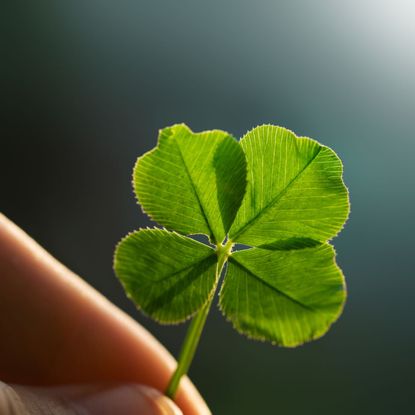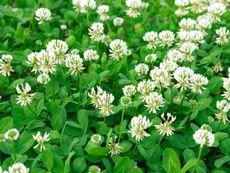What Causes Four Leaf Clovers And How To Find A Four Leaf Clover


Ah, the four leaf clover… so much to be said about this misfit of nature. Some people look all their lives for that lucky four leaf clover without success, while others (like me and my kids) could find them all day long. But exactly what causes four leaf clovers, why are they considered so lucky, and how do you successfully go about finding four leaf clovers? Read on to find out.
About Four Leaf Clovers
Before you begin your search for that seemingly ‘mystical' clover specimen, it helps to have a little background info about four leaf clovers. We all know that it is thought to bring good luck to the finder (Yeah right. I find them all the time and if it weren't for my bad luck, I'd have no luck at all!), but did you know that St. Patrick is said to have used the three-leaf clover to explain the Holy Trinity to the pagan Irish, and the fourth leaf is believed to represent God's grace. Additional information points to the four leaves of clover as representing faith, hope, love, and luck. And in the Middle Ages, a clover with four leaves not only meant good luck but was believed to grant one the ability to see fairies (just so you know, I have yet to see one). The elusive four leaf clover occurs in white clover (Trifolium repens). You know the one. That common weed popping up in yards everywhere and is difficult to control once it's taken hold. A white clover leaf should, generally, only have three leaflets - which is why the species name is trifolium; ‘tri' means three. However, many times (more often than you would think) you will come across a clover with four leaves, five leaves (cinquefoil) or even more - my kids have a knack for finding clovers having six or even seven leaves. So why does this happen and how rare is it?
What Causes Four Leaf Clovers?
When you're looking for answers to what causes four leaf clovers, the scientific response is normally, “We aren't quite sure why it happens.” There are, however, a number of theories.
- Four leaf clovers are believed to be mutations of the white clover. They are also said to be quite uncommon, with only about 1 in 10,000 plants producing a clover with four leaves. (I would argue with that since we seem to find them regularly.)
- The number of leaflets on clovers is genetically determined. Tests have shown that phenotypic traits within the DNA of the cells of the plant may explain this phenomenon. In fact, the genes that produce four leaves are recessive to the genes that produce three. Generally speaking, the number of three leaf clovers for every four leaf clover is about 100 to 1. With odds like that, it is considered lucky to find one - not so much that it brings you luck.
- Another reason for clovers with four leaves instead of three is due to plant breeding. New strains of the plant are biologically bred to produce more four leaf clovers. I guess that could explain why there seem to be lots more, or at least a lot easier to find.
- Finally, certain factors within the plant's natural environment can play a role in the number of four leaf clovers. Things like heredity combined with exposure to certain chemicals or low levels of radiation may possibly increase the rate of mutation and frequency of occurrence for future clover generations.
How to Find a Four Leaf Clover
So if it's been said that about one out of every 10,000 clovers will have four leaves and nearly 200 clovers are found in a 24-inch (61 cm.) square plot, what does this mean exactly? And what are your chances of finding four leaf clovers? Simply put, in an area roughly 13 square feet (1.2 sq. m.), you should find at least one four-leaf clover. Like I keep saying, it's not as difficult as one might think to find a four leaf clover. My secret to success, and apparently others too as I found in my research, is not to look for them at all. If you get down on those hands and knees looking through each individual clover, not only will you end up with back or knee pain but you'll surely go cross-eyed. Just casually walk around that clover bed instead, perusing the area, and eventually, those four leaf clovers (or five and six leaf ones) will actually begin to ‘stick out' amongst the more common three leaf clovers. Feeling lucky yet? Give it a try.
Gardening tips, videos, info and more delivered right to your inbox!
Sign up for the Gardening Know How newsletter today and receive a free download of our most popular eBook "How to Grow Delicious Tomatoes."

Nikki Tilley has been gardening for nearly three decades. The former Senior Editor and Archivist of Gardening Know How, Nikki has also authored six gardening books.
-
 Urban Beekeeping Guide: Top Tips For Raising Bees In The City
Urban Beekeeping Guide: Top Tips For Raising Bees In The CityUrban beekeeping can be a rewarding and appreciated pastime, but first be sure it’s legal in your city and learn the ropes of beekeeping.
By Mary Ellen Ellis
-
 2024 Plant Of The Year: Why Experts Say Philodendron Is The “It” Plant Of The Year
2024 Plant Of The Year: Why Experts Say Philodendron Is The “It” Plant Of The YearWe aren’t surprised that philodendron was designated the plant of the year. Versatile, easy-care and lovely, it’s the houseplant of the year 2024!
By Bonnie L. Grant
